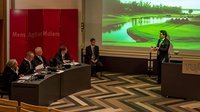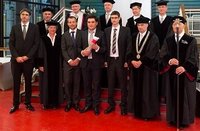Pulsed electric discharges have important applications, such as purifying polluted air in highway tunnels, disinfection and wound healing. As physical and chemical processes in pulsed discharges occur on a large variety of scales, it is difficult to model them. Mathematician Aram Markosyan, PhD candidate from Centrum Wiskunde & Informatica (CWI), developed better models for these discharges and designed an open source software package ‒ PumpKin ‒ to analyze the chemical reactions initiated by discharges on different time scales. On Monday, 19 May, he defended his PhD thesis 'Modeling multiple time scales in streamer discharges' at Eindhoven University of Technology. There is much interest from both industry and academia in this research.
Pulsed discharges are created by applying sudden high voltage differences to air, traffic exhaust and other gases. In short-living discharges of tens of nanoseconds, the gas isn’t hot. The electrons gain very high energies and collide with the molecules, triggering a chain of chemical reactions. These chemical products are very useful for, for instance, painless wound healing or disinfection. For both the initial and later stage of the discharge, Markosyan improved the models and simulations.


The research results can be used to describe the chemical composition of the atmosphere in climate research, for plasma research, for the design of high-voltage switches and for other energy and cost efficient streamer applications. These tools can also be used for development of efficient renewable energy storages by recycling carbon dioxide. The research was funded by STW and was performed in the Multiscale Dynamics research group at CWI, under supervision of Ute Ebert. Energy is one of the key research areas of the Amsterdam-based Centrum Wiskunde & Informatica.
More information:
- the homepage of the Multiscale Dynamics research group at CWI
- the PumpKin code en manual: http://www.pumpkin-tool.org
Pictures above: Armen Inants (Inria)

Discharges. Picture: Sander Nijdam, TU/e.
